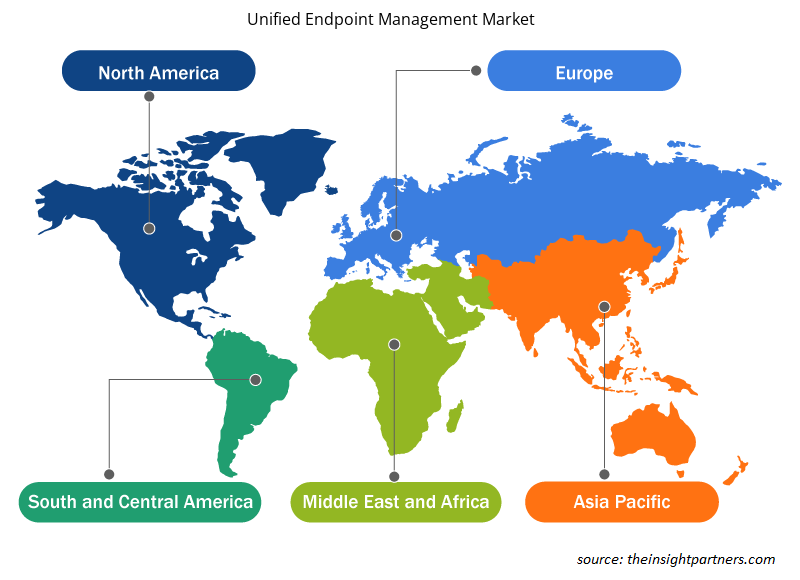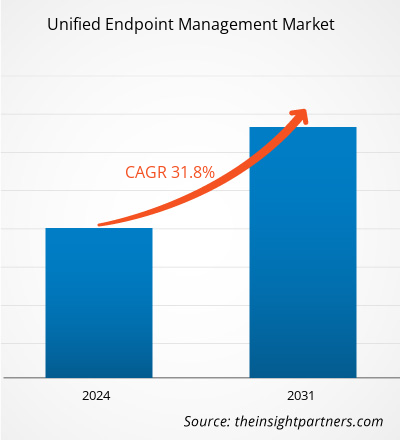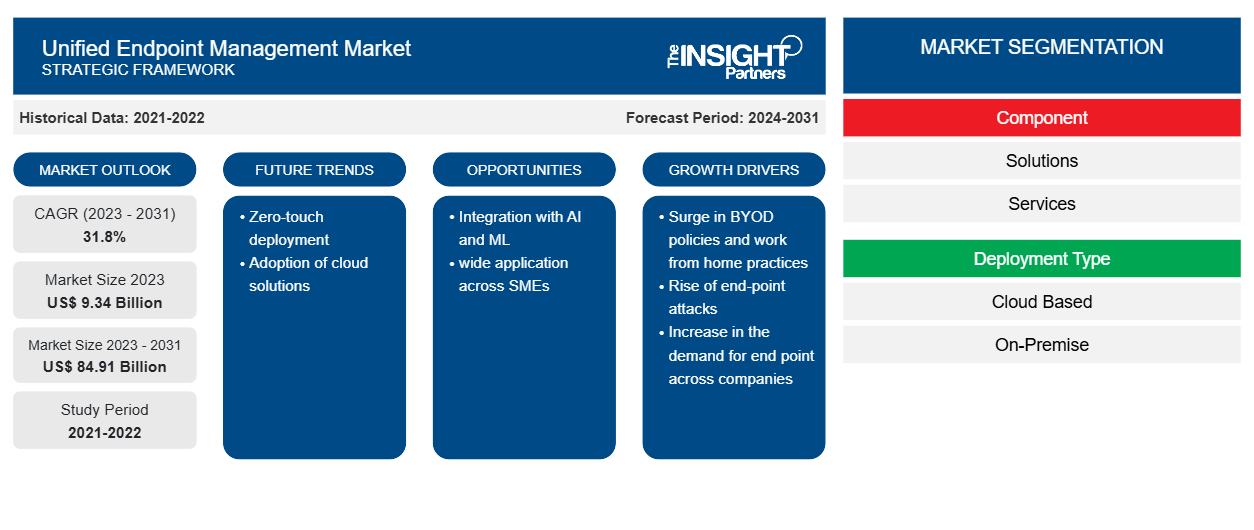Si prevede che la dimensione del mercato della gestione unificata degli endpoint raggiungerà gli 84,91 miliardi di dollari entro il 2031, rispetto ai 9,34 miliardi di dollari del 2023. Si stima che il mercato registrerà un CAGR del 31,8% nel periodo 2023-2031. L'implementazione zero-touch e l'adozione di soluzioni basate su cloud nelle aziende porteranno probabilmente nuove tendenze sul mercato.
Analisi di mercato della gestione unificata degli endpoint
La crescente domanda di elevata sicurezza e gestione efficiente degli endpoint e la tendenza crescente di una forza lavoro mobile spingono l'adozione di soluzioni di gestione unificata degli endpoint in aziende di diverse dimensioni. Con la crescente tendenza alla digitalizzazione, ai luoghi di lavoro intelligenti e all'automazione, si prevede che la domanda di soluzioni di gestione unificata degli endpoint aumenterà rapidamente nei prossimi anni.
I progressi nella tecnologia informatica e nelle applicazioni digitali hanno aumentato le risorse IT in tutto il mondo. In base al rapporto di Cisco, entro la fine del 2021 ci saranno oltre 27,1 miliardi di dispositivi connessi a Internet. Le aziende stanno adottando sempre più modelli di fascia alta per soddisfare i requisiti hardware per sistemi operativi aggiornati come Windows 10 e ChromeOS. Con il crescente utilizzo di endpoint come laptop, tablet, telefoni cellulari e desktop nelle aziende, la necessità di gestire questi endpoint da un'unica piattaforma è in aumento, con conseguente aumento della domanda di soluzioni unificate. La crescente tendenza a implementare policy che consentano ai dispositivi personali di accedere ai dati aziendali è un altro fattore che guida il mercato.
Panoramica del mercato della gestione unificata degli endpoint
Gli strumenti di gestione unificata degli endpoint (UEM) offerti da varie aziende consentono ai clienti di gestire e proteggere tutti i server, i dispositivi e gli endpoint di un'organizzazione da una console unificata. È anche una combinazione di diverse soluzioni come la gestione della mobilità aziendale , la gestione dei contenuti mobili, la gestione delle applicazioni mobili, la gestione dei dispositivi mobili e la gestione dei client. Le soluzioni di gestione unificata degli endpoint coprono diverse piattaforme, come Windows, macOS, iOS, Android e Wear OS, su vari dispositivi, tra cui desktop, laptop, smartphone, tablet e dispositivi indossabili. Queste soluzioni supportano tutti i casi di utilizzo della mobilità nelle organizzazioni, dai dispositivi di proprietà aziendale, creati appositamente o condivisi ai dispositivi BYOD. I principali vantaggi delle soluzioni di gestione unificata degli endpoint includono la gestione degli endpoint, la gestione dei profili utente, i dashboard, i report, la gestione dei dispositivi mobili e la patching e la sicurezza degli endpoint. Grazie a tutte le funzionalità e ai vantaggi, queste soluzioni e i servizi correlati stanno diventando sempre più popolari tra i settori IT e delle telecomunicazioni, sanità, BFSI, governo, vendita al dettaglio e altri utenti finali.
Personalizza questo report in base alle tue esigenze
Riceverai la personalizzazione gratuita di qualsiasi report, comprese parti di questo report, o analisi a livello nazionale, pacchetto dati Excel, oltre a usufruire di grandi offerte e sconti per start-up e università
-
Scopri le principali tendenze di mercato in questo rapporto.Questo campione GRATUITO includerà analisi di dati che spaziano dalle tendenze di mercato alle stime e alle previsioni.
Driver e opportunità di mercato per la gestione unificata degli endpoint
Aumento delle politiche BYOD e delle pratiche di lavoro da casa
L'inizio della pandemia di COVID-19 ha portato a una maggiore adozione del modello di lavoro da casa, portando a un aumento delle politiche BYOD in varie organizzazioni. BYOD consente ai dipendenti di utilizzare dispositivi personali come tablet, computer e smartphone per accedere a dati aziendali riservati, risorse e applicazioni. Secondo il rapporto di Cybersecurity Insiders 2021, in totale, l'82% delle organizzazioni utilizza BYOD. Un sondaggio condotto da 271 professionisti della sicurezza informatica ha rilevato che il 70% delle organizzazioni ha dipendenti che portano i propri dispositivi sul posto di lavoro. BYOD è applicabile anche a appaltatori (26% delle organizzazioni), partner (21%), clienti (18%) e fornitori (14%). Inoltre, secondo Jamf, a luglio 2023, circa il 75% delle persone utilizzava dispositivi personali per il lavoro d'ufficio, il che ha comportato un aumento del 34% della produttività; inoltre, le organizzazioni possono risparmiare circa 250 $ USA per dipendente con una politica BYOD più stipendio. La gestione unificata degli endpoint aiuta a gestire le policy BYOD delle organizzazioni e fornisce misure di sicurezza robuste come crittografia e controlli di accesso sicuri, che sono fondamentali per proteggere i dati aziendali sui dispositivi personali. Inoltre, i luoghi di lavoro comprendono una combinazione di lavoratori in ufficio, ibridi e remoti che utilizzano sempre di più i propri dispositivi personali per lavorare da qualsiasi luogo. Ad esempio, a dicembre 2022, secondo "The National Institute of Standards and Technology", oltre il 95% delle organizzazioni ha consentito ai dipendenti di utilizzare i propri dispositivi per lavorare da casa. Inoltre, secondo Finance Online, la pandemia di COVID-19 ha portato l'85% delle aziende a implementare policy BYOD. La crescente implementazione di BYOD esercita pressione sulle organizzazioni per monitorare il lavoro da remoto complessivo dei dipendenti poiché è aumentata la diversità dei dispositivi che accedono alle reti aziendali. Le soluzioni di gestione unificata degli endpoint forniscono una gestione centralizzata per tutti gli endpoint. Pertanto, l'aumento delle policy BYOD e delle pratiche di lavoro da casa aumenta la domanda di soluzioni di gestione unificata degli endpoint, che alimenta la crescita del mercato.
Integrazione con intelligenza artificiale e apprendimento automatico
Le tecnologie avanzate stanno cambiando rapidamente il modo in cui opera il settore IT. Le soluzioni di gestione degli endpoint unificati sfruttano la potenza dell'intelligenza artificiale e delle integrazioni di apprendimento automatico per ampliare la strategia di sicurezza complessiva con analisi contestuali e approfondimenti più approfonditi. Con metodologie all'avanguardia, i team di sicurezza sono in grado di ricevere suggerimenti su avvisi, policy di settore, minacce dannose, ecc., che aiutano ad aumentare la produttività e a proteggere il loro ambiente. La sicurezza basata sull'apprendimento automatico fornisce un'architettura zero-trust che utilizza un'autorizzazione multifattoriale efficiente e altri diritti di autenticazione, crittografia, analisi e livello di file system per prevenire la perdita di dati critici. Inoltre, applicando regole di accesso dinamiche basate sui dispositivi, l'identità e il contesto dell'utente, è possibile garantire che solo le applicazioni e gli utenti autorizzati possano accedere alla superficie di protezione.
La maggior parte dei provider di gestione unificata degli endpoint sta incorporando AI e ML nelle proprie linee di prodotti per aumentare il proprio valore e differenziare le proprie offerte. La gestione integrata degli endpoint basata su AI fornisce un approccio diffuso alla gestione dei dispositivi che può migliorare la sicurezza. Utilizzando algoritmi AI per automatizzare molte delle attività associate alla gestione dei dispositivi endpoint, le organizzazioni possono ridurre il rischio di violazioni della sicurezza. Inoltre, fornendo informazioni in tempo reale sullo stato di salute e sui modelli di utilizzo dei dispositivi, la gestione unificata degli endpoint basata su AI può aiutare le organizzazioni a stabilire le priorità dei problemi e ad agire prima che diventino problemi significativi. Inoltre, diverse aziende stanno integrando AI e ML con la gestione unificata degli endpoint, tra cui Blackberry. Pertanto, è probabile che l'integrazione di intelligenza artificiale e apprendimento automatico con soluzioni di gestione unificata degli endpoint crei nuove opportunità per la crescita del mercato durante il periodo di previsione.
Analisi della segmentazione del rapporto di mercato sulla gestione degli endpoint unificata
I segmenti chiave che hanno contribuito alla derivazione dell'analisi di mercato della gestione unificata degli endpoint sonocomponente, distribuzione, piattaforma, dimensioni dell'organizzazione, utente finale e area geografica.
- In base al componente, il mercato è diviso in soluzioni e servizi. Il segmento delle soluzioni ha dominato il mercato nel 2023.
- Per distribuzione, il mercato della gestione unificata degli endpoint è diviso in cloud-based e on-premise. Il segmento basato su cloud ha dominato il mercato nel 2023.
- In termini di piattaforma, il mercato della gestione unificata degli endpoint è diviso in desktop e mobile. Il segmento desktop ha detenuto una quota maggiore del mercato nel 2023.
- In base alle dimensioni dell'organizzazione, il mercato della gestione unificata degli endpoint è diviso in PMI e grandi imprese. Il segmento delle grandi imprese ha dominato il mercato nel 2023.
- In termini di utente finale, il mercato è segmentato in BFSI, IT e telecomunicazioni, sanità, automotive, produzione, vendita al dettaglio e altri. Il segmento IT e telecomunicazioni ha dominato il mercato nel 2023.
Analisi della quota di mercato di Unified Endpoint Management per area geografica
Il mercato della gestione unificata degli endpoint è segmentato in cinque regioni principali: Nord America, Europa, Asia Pacifico (APAC), Medio Oriente e Africa (MEA) e Sud e Centro America. Il Nord America ha dominato il mercato nel 2023, seguito da Europa e APAC.
Il mercato della gestione unificata degli endpoint del Nord America sta crescendo in modo significativo grazie ai crescenti investimenti delle aziende in tecnologie avanzate per semplificare le loro operazioni. Inoltre, la presenza di un gran numero di fornitori di gestione unificata degli endpoint e i loro sforzi costanti per fornire soluzioni di sicurezza offrendo al contempo funzionalità di gestione degli endpoint di alta qualità alimentano la crescita del mercato nel Nord America. Inoltre, la disponibilità e l'adozione tempestive di strumenti di sicurezza digitale in tutta la regione svolgono un ruolo importante nel promuovere l'adozione di soluzioni di gestione unificata degli endpoint.
Approfondimenti regionali sul mercato della gestione unificata degli endpoint
Le tendenze regionali e i fattori che influenzano il mercato Unified Endpoint Management durante il periodo di previsione sono stati ampiamente spiegati dagli analisti di Insight Partners. Questa sezione discute anche i segmenti e la geografia del mercato Unified Endpoint Management in Nord America, Europa, Asia Pacifico, Medio Oriente e Africa e America meridionale e centrale.

- Ottieni i dati specifici regionali per il mercato Unified Endpoint Management
Ambito del rapporto di mercato sulla gestione degli endpoint unificata
| Attributo del report | Dettagli |
|---|---|
| Dimensioni del mercato nel 2023 | 9,34 miliardi di dollari USA |
| Dimensioni del mercato entro il 2031 | 84,91 miliardi di dollari USA |
| CAGR globale (2023-2031) | 31,8% |
| Dati storici | 2021-2022 |
| Periodo di previsione | 2024-2031 |
| Segmenti coperti |
Per componente
|
| Regioni e Paesi coperti |
America del Nord
|
| Leader di mercato e profili aziendali chiave |
|
Densità degli attori del mercato della gestione unificata degli endpoint: comprendere il suo impatto sulle dinamiche aziendali
Il mercato Unified Endpoint Management Market sta crescendo rapidamente, spinto dalla crescente domanda degli utenti finali dovuta a fattori quali l'evoluzione delle preferenze dei consumatori, i progressi tecnologici e una maggiore consapevolezza dei vantaggi del prodotto. Con l'aumento della domanda, le aziende stanno ampliando le loro offerte, innovando per soddisfare le esigenze dei consumatori e capitalizzando sulle tendenze emergenti, il che alimenta ulteriormente la crescita del mercato.
La densità degli operatori di mercato si riferisce alla distribuzione di aziende o società che operano in un particolare mercato o settore. Indica quanti concorrenti (operatori di mercato) sono presenti in un dato spazio di mercato in relazione alle sue dimensioni o al valore di mercato totale.
Le principali aziende che operano nel mercato della gestione unificata degli endpoint sono:
- 42Gears Mobility Systems Pvt Ltd.
- BlackBerry Italia
- Matrix42 Italia
- MobileIron Inc
- Ivanti
- Citrix Systems Inc
Disclaimer : le aziende elencate sopra non sono classificate secondo un ordine particolare.

- Ottieni una panoramica dei principali attori del mercato Unified Endpoint Management
Notizie di mercato e sviluppi recenti sulla gestione unificata degli endpoint
Il mercato della gestione unificata degli endpoint viene valutato raccogliendo dati qualitativi e quantitativi dopo la ricerca primaria e secondaria, che include importanti pubblicazioni aziendali, dati associativi e database. Di seguito sono elencati alcuni degli sviluppi nel mercato della gestione unificata degli endpoint:
- HCL Software, leader mondiale nelle soluzioni software aziendali, ha annunciato il lancio delle sue soluzioni BigFix Workspace ed Enterprise, rivoluzionando la gestione degli endpoint e l'automazione della sicurezza per le organizzazioni in tutto il mondo. Con un focus sul miglioramento dell'esperienza digitale dei dipendenti e sulla garanzia di una conformità normativa senza soluzione di continuità, queste offerte innovative ridefiniscono il modo in cui le aziende affrontano la gestione degli endpoint in un panorama dinamico.
(Fonte: HCL Software, comunicato stampa, marzo 2024)
- BlackBerry Limited, pioniere della gestione della mobilità aziendale, ha annunciato due importanti innovazioni in ambito Unified Endpoint Management (UEM): BlackBerry UEM at the Edge e BlackBerry UEM per l'IoT.
(Fonte: BlackBerry Limited, comunicato stampa, ottobre 2023)
Copertura e risultati del rapporto di mercato sulla gestione degli endpoint unificata
"Dimensioni e previsioni del mercato di Unified Endpoint Management (2021-2031)" fornisce un'analisi dettagliata del mercato che copre le aree menzionate di seguito:
- Dimensioni e previsioni del mercato della gestione unificata degli endpoint a livello globale, regionale e nazionale per tutti i segmenti di mercato chiave coperti dall'ambito
- Tendenze del mercato della gestione degli endpoint unificati e dinamiche di mercato come driver, vincoli e opportunità chiave
- Analisi PEST e SWOT dettagliate
- Analisi di mercato della gestione unificata degli endpoint che copre le principali tendenze di mercato, il quadro globale e regionale, i principali attori, le normative e i recenti sviluppi del mercato
- Analisi del panorama industriale e della concorrenza che copre la concentrazione del mercato, l'analisi della mappa di calore, i principali attori e gli sviluppi recenti per il mercato della gestione unificata degli endpoint
- Profili aziendali dettagliati
- Analisi storica (2 anni), anno base, previsione (7 anni) con CAGR
- Analisi PEST e SWOT
- Valore/volume delle dimensioni del mercato - Globale, Regionale, Nazionale
- Industria e panorama competitivo
- Set di dati Excel
Report recenti
Rapporti correlati
Testimonianze
Motivo dell'acquisto
- Processo decisionale informato
- Comprensione delle dinamiche di mercato
- Analisi competitiva
- Analisi dei clienti
- Previsioni di mercato
- Mitigazione del rischio
- Pianificazione strategica
- Giustificazione degli investimenti
- Identificazione dei mercati emergenti
- Miglioramento delle strategie di marketing
- Aumento dell'efficienza operativa
- Allineamento alle tendenze normative























 Ottieni un campione gratuito per - Mercato della gestione unificata degli endpoint
Ottieni un campione gratuito per - Mercato della gestione unificata degli endpoint